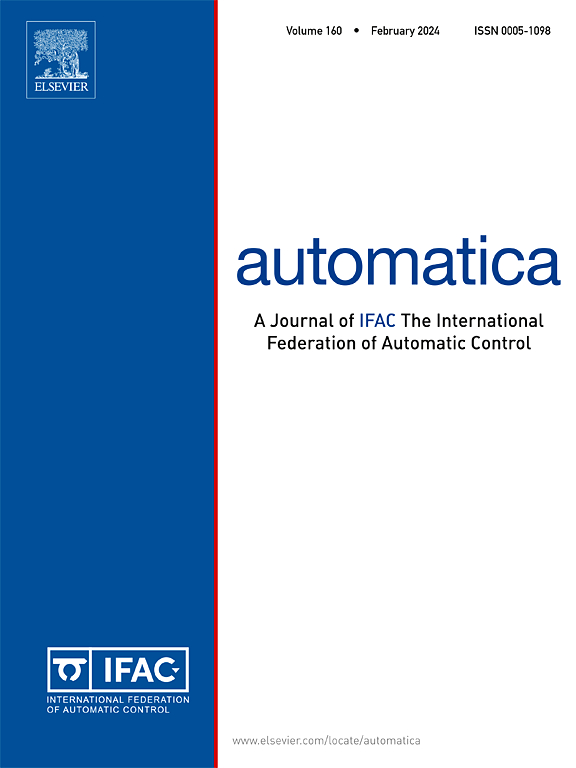间歇感知下Kuramoto-Sivashinsky方程的自适应边界控制
IF 5.9
2区 计算机科学
Q1 AUTOMATION & CONTROL SYSTEMS
引用次数: 0
摘要
本文研究了受间断传感影响的扰动Kuramoto-Sivashinsky (KS)方程在L2意义上的边界稳定问题。我们假设在一定的时间间隔内测量给定空间子域上的状态,而在剩余的时间间隔内测量剩余空间子域上的状态。我们在空间域的边界处分配一个反馈律,并将两个子域交界处的状态值强制为零。在整个研究中,假设方程的不稳定系数是未知的,可能与空间有关,但有界。因此,在不同的摄动假设下,设计了自适应边界控制器。特别是,当扰动大小的上界已知时,我们保证了输入-状态稳定性(ISS)。否则,只保证全局一致最终有界性(GUUB)。相反,当在所有时间的每个空间点测量状态(全状态测量)时,即使扰动的最大尺寸未知,也可以保证收敛到原点的任意小邻域。通过数值模拟来说明我们的结果。本文章由计算机程序翻译,如有差异,请以英文原文为准。
Adaptive boundary control of the Kuramoto–Sivashinsky equation under intermittent sensing
We study in this paper boundary stabilization, in the sense, of the perturbed Kuramoto–Sivashinsky (KS) equation subject to intermittent sensing. We assume that we measure the state on a given spatial subdomain during certain time intervals, while we measure the state on the remaining spatial subdomain during the remaining time intervals. We assign a feedback law at the boundary of the spatial domain and force to zero the value of the state at the junction of the two subdomains. Throughout the study, the equation’s destabilizing coefficient is assumed to be unknown and possibly space dependent but bounded. As a result, adaptive boundary controllers are designed under different assumptions on the perturbation. In particular, we guarantee input-to-state stability (ISS) when an upperbound on the perturbation’s size is known. Otherwise, only global uniform ultimate boundedness (GUUB) is guaranteed. In contrast, when the state is measured at every spatial point all the time (full state measurement), convergence to an arbitrarily-small neighborhood of the origin is guaranteed, even if the perturbation’s maximal size is unknown. Numerical simulations are performed to illustrate our results.
求助全文
通过发布文献求助,成功后即可免费获取论文全文。
去求助
来源期刊

Automatica
工程技术-工程:电子与电气
CiteScore
10.70
自引率
7.80%
发文量
617
审稿时长
5 months
期刊介绍:
Automatica is a leading archival publication in the field of systems and control. The field encompasses today a broad set of areas and topics, and is thriving not only within itself but also in terms of its impact on other fields, such as communications, computers, biology, energy and economics. Since its inception in 1963, Automatica has kept abreast with the evolution of the field over the years, and has emerged as a leading publication driving the trends in the field.
After being founded in 1963, Automatica became a journal of the International Federation of Automatic Control (IFAC) in 1969. It features a characteristic blend of theoretical and applied papers of archival, lasting value, reporting cutting edge research results by authors across the globe. It features articles in distinct categories, including regular, brief and survey papers, technical communiqués, correspondence items, as well as reviews on published books of interest to the readership. It occasionally publishes special issues on emerging new topics or established mature topics of interest to a broad audience.
Automatica solicits original high-quality contributions in all the categories listed above, and in all areas of systems and control interpreted in a broad sense and evolving constantly. They may be submitted directly to a subject editor or to the Editor-in-Chief if not sure about the subject area. Editorial procedures in place assure careful, fair, and prompt handling of all submitted articles. Accepted papers appear in the journal in the shortest time feasible given production time constraints.
 求助内容:
求助内容: 应助结果提醒方式:
应助结果提醒方式:


